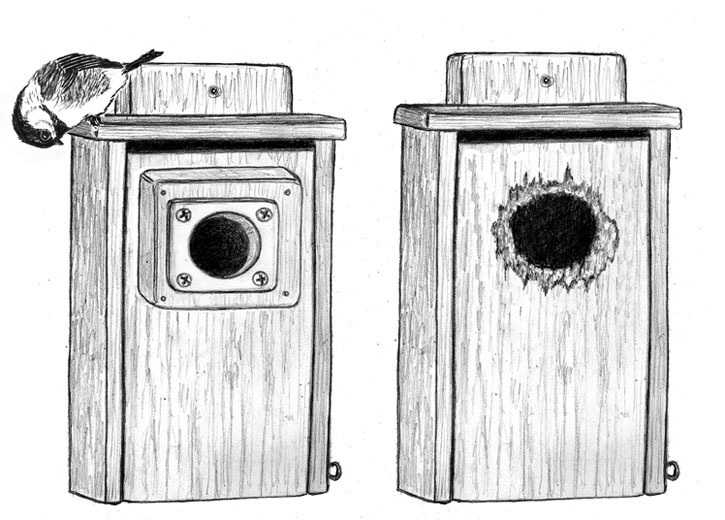
Dear Bird Folks,
Several of my birdhouses have had their entrance holes chewed larger by something. Now I have to buy all new houses. Any idea what creature is doing the chewing and how I can prevent it from happening to my new boxes?
– Bob, Dalton, MA
Hold on, Bob,
Don’t run out and buy new birdhouses just yet. I know it’s not my style to talk someone out of purchasing new bird stuff, but I have my reasons. You might be able to fix your old boxes fairly easily. Also, a chewed opening can actually be a good thing. How is that, you ask? I don’t want to be accused of body shaming, but some birds are simply too fat to squeeze through traditional entrance holes. More on that later. First, we have to identify the chewer. Here’s a hint: No one knows.
A high percentage of my customers have the same complaint you have. Something is chewing the openings of their birdhouses, and yet not a single one of them knows the ID of the chewer. This makes me wonder: What are these people doing all day long? Why aren’t they staring at their birdhouses? That’s what I do. With the lack of hard evidence we are forced to go with the most likely perpetrator, our old pal the gray squirrel. The villain could also be a red squirrel, or a flying squirrel, or a chipmunk, or even a woodpecker. All of these creatures have a history of chewing stuff and all of them possess the carpentry tools needed to do damage. But at the end of the day, knowing what did the chewing isn’t really all that important. Right? It’s not like we’re going to call the cops or report them to neighborhood association. We just have to fix it, and most of the time the fix is simple.
Many birdhouse companies sell a product known as a “predator guard.” A predator guard is basically a block of wood with a hole in it. The idea of the guard is to keep predators (usually raccoons) from reaching into the box and stealing eggs or nestlings. These guards are also great for patching up chewed entrance holes, as they are often large enough to cover the damaged area. Now the birdhouses are as good as new. And predator guards are cheap, much cheaper than buying a new birdhouse. They are also easy to make. Heck, even I can drill a hole into a block of wood…I think.
If you want to keep your new predator guard from also being chewed, or if you want to add a bit of protection to your not-yet-chewed birdhouses, there is something else you can do, and it’s equally as cheap. There’s a company in Chicago that makes a metal plate for the outside of the hole. The metal prevents even the most aggressive squirrels from enlarging the opening. The company calls these plates “portals.” That name sounded too clinical to us, so we call them “squirrel tooth benders.” (I’d like to say our name is more descriptive, but it mostly confuses people.) Tooth benders come in a variety of sizes in order to accommodate birds ranging from wrens to bluebirds. A different company sells fancier plates, which are made out of slate instead of metal, but these slate plates are a lot more expensive and are usually reserved for birds that live in gated communities.
In addition to saving a little dough, repairing a birdhouse has another advantage. For whatever reason, birds seem to have a favorite birdhouse. They often use the same box year after year and hate to give it up. For example: For fifteen years in a row, a pair of chickadees used the same nest box in my yard. (No, they weren’t the same birds for the entire fifteen years. Chickadees don’t live that long…even the ones that don’t smoke.) Eventually, the original box disintegrated and I had to replace it. I put out a brand new box, which was similar to the old one, but come spring no chickadee wanted anything to do with it. They must have had a case of metathesiophobia (fear of change). The box sat empty for the entire summer. But I’m happy to report that the birds returned the following spring and have been using the new box ever since. I guess they only had a mild case of metathesiophobia.
When it comes to encouraging folks to use metal plates (aka, portals, aka, squirrel tooth benders), I’m a little conflicted. Yes, the plates will keep your birdhouse entrance hole from being chewed, but as I mentioned earlier, some birds need larger holes. At least a dozen times a summer customers will report a “strange” bird using one of their chewed boxes. This bird invariably turns out to be a Great-crested Flycatcher. Great-crested Flycatchers are also cavity-nesting birds, but they’re big, about the size of a catbird, which makes them too large to squeeze into the hole of a traditional birdhouse. Since few folks are aware of this bird, they rarely put up boxes specifically for them. The flycatchers are left searching for old flicker nests or a birdhouse with a hole chewed larger by some mystery creature.
If I were you, Bob, I would patch up your damaged boxes with wooden predator guards and then add metal plates for further protection. And with the money you’ve saved by making those simple repairs, you can go out and buy a brand new box specifically for the Great-crested Flycatchers. I realize that putting out a new and different box might be a change for you, but you should do it anyhow. The last thing you want is to have your neighbors accuse you of having a case of metathesiophobia…or worse, make you pronounce it.